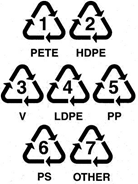26.7 Polymer Recycling and Disposal
- Page ID
- 30973
Most plastics crumble into ever-tinier fragments as they are exposed to sunlight and the elements. Except for the small amount that's been incinerated–and it's a very small amount–every bit of plastic ever made still exists, unless the material's molecular structure is designed to favor biodegradation. Unfortunately, cleaning up the garbage patch is not a realistic option, and unless we change our disposal and recycling habits, it will undoubtedly get bigger. One sensible solution would require manufacturers to use natural biodegradable packaging materials whenever possible, and consumers to conscientiously dispose of their plastic waste. Thus, instead of consigning all plastic trash to a land fill, some of it may provide energy by direct combustion, and some converted for reuse as a substitute for virgin plastics. The latter is particularly attractive since a majority of plastics are made from petroleum, a diminishing resource with a volatile price.
The energy potential of plastic waste is relatively significant, ranging from 10.2 to 30.7MJ kg Ã, suggesting application as an energy source and temperature stabilizer in municipal incinerators, thermal power plants and cement kilns. The use of plastic waste as a fuel source would be an effective means of reducing landfill requirements while recovering energy. This, however, depends on using appropriate materials. Inadequate control of combustion, especially for plastics containing chlorine, fluorine and bromine, constitutes a risk of emitting toxic pollutants.
Whether used as fuels or a source of recycled plastic, plastic waste must be separated into different categories. To this end, an identification coding system was developed by the Society of the Plastics Industry (SPI) in 1988, and is used internationally. This code, shown on the right, is a set of symbols placed on plastics to identify the polymer type, for the purpose of allowing efficient separation of different polymer types for recycling. The abbreviations of the code are explained in the following table.
|
|
||||||||||||||||
Despite use of the recycling symbol in the coding of plastics, there is consumer confusion about which plastics are readily recyclable. In most communities throughout the United States, PETE and HDPE are the only plastics collected in municipal recycling programs. However, some regions are expanding the range of plastics collected as markets become available. (Los Angeles, for example, recycles all clean plastics numbered 1 through 7) In theory, most plastics are recyclable and some types can be used in combination with others. In many instances, however, there is an incompatibility between different types that necessitates their effective separation. Since the plastics utilized in a given manufacturing sector (e.g. electronics, automotive, etc.) is generally limited to a few types, effective recycling is often best achieved with targeted waste streams.
Recycled Plastics
|
|
|
|
|---|---|---|
|
|
|
Many types of clear plastic consumer bottles, including clear, 2-liter beverage bottles |
|
|
|
Milk jugs, detergent bottles, some water bottles, some grocery plastic bags |
|
|
|
Plastic drain pipe, shower curtains, some water bottles |
|
|
|
Plastic garbage and other bags, garment bags, snap-on lids such as coffee can lids |
|
|
|
Many translucent (or opaque) plastic containers; containers for some products such as yogurt, soft butter, or margarine; aerosol can tops; rigid bottle caps; candy wrappers; bottoms of bottles |
|
|
|
Hard clear plastic cups, foam cups, eating utensils, deli food containers, toy model kits, some packing popcorn |
|
|
|
Polycarbonate is a common type, Biodegradable, Some packing popcorn |



